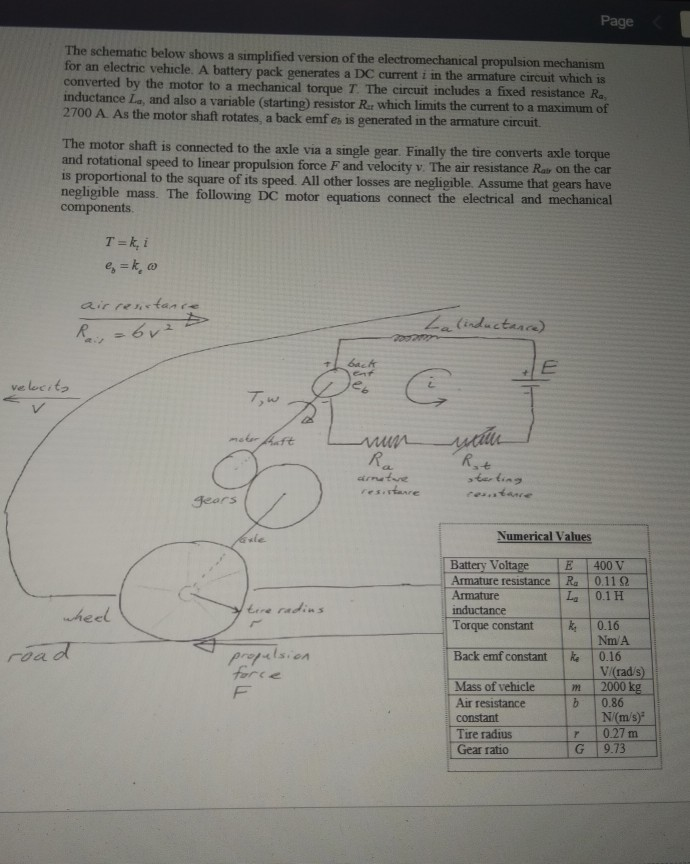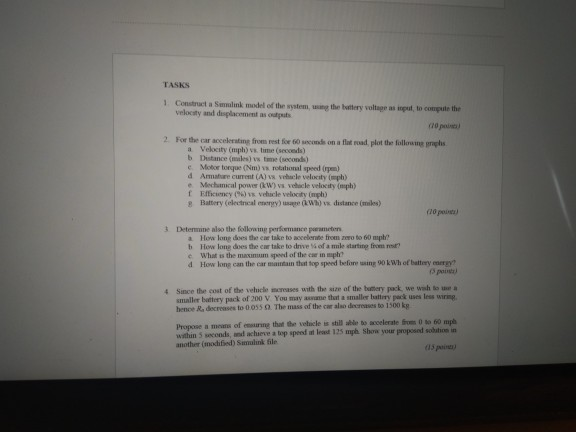Answered step by step
Verified Expert Solution
Question
1 Approved Answer
The first image is the theory behind it and the second image is the questions itself Page The schematic below shows a simplified version of


The first image is the theory behind it and the second image is the questions itself
Page The schematic below shows a simplified version of the electromechanical propulsion mechanism for an electric vehicle. A battery pack generates a DC current i in the armature circuit which is converted by the motor to a mechanical torque T. The circuit includes a fixed resistance Ra, inductance La, and also a variable (starting) resistor R. which limits the current to a maximum of 2700 A. As the motor shaft rotates, a back emf es is generated in the armature circuit. The motor shaft is connected to the axle via a single gear. Finally the tire converts axle torque and rotational speed to linear propulsion force F and velocity v. The air resistance Ras on the car 15 proportional to the square of its speed. All other losses are negligible. Assume that gears have negligible mass. The following DC motor equations connect the electrical and mechanical components T=ki G=ko air resistance R = 6v ctance) velocity car Aft mun util Ra TRE retu resistance ret gears Numerical Values Battery Voltage Armature resistance Armature inductance Torque constant E Ra L. 400 V 0.11 22 0.1 H Erre radius wheel road propulsion Back emf constant ke orce m b Mass of vehicle Air resistance constant Tire radius Gear ratio 0.16 NmA 0.16 V/(rad/s) 2000 kg 0.86 N/(m/s) 0.27 m 9.73 G TASKS 1 Construct a Smalik model of the wystem, velocity and displacement as the battery voltage as out to compute the (70 pm 2 For the car accelerating from rest for and on a flat road, plot the followings a Velocity (mph) (cs) b Distance (m ) v e (seconds) e Motor torque (Nm) rotational speed up) d Amare current (A) hele velocity (ph) Mechanical power (kW) vedle velocity (mph) f f y (9) vehicle velocity mph) Battery (electrical entry) (Wh) distance (miles) 3 Determine also the followme performance permeten # How long does the ene tak to bere from to 60 mph h How long does the c ake to drive of a me starting from What is the maximum of the car in mph d How long can the car maintain the top speed before in kWh of battery # Since the cost of the vehicle m ases with the size of the battery pack we wish to maller battery pack of 200 V You may wametoa maller bully pack seless wir hence Re decreases to 0.055 . The mass of the car al decreases to 1500 kg Proposames of that the velle is still able to selerate from 0 to 60 mph within 3 seconds and achieve a top spend a lot 125 mh Show your proposed soos in another modified Smink file Page The schematic below shows a simplified version of the electromechanical propulsion mechanism for an electric vehicle. A battery pack generates a DC current i in the armature circuit which is converted by the motor to a mechanical torque T. The circuit includes a fixed resistance Ra, inductance La, and also a variable (starting) resistor R. which limits the current to a maximum of 2700 A. As the motor shaft rotates, a back emf es is generated in the armature circuit. The motor shaft is connected to the axle via a single gear. Finally the tire converts axle torque and rotational speed to linear propulsion force F and velocity v. The air resistance Ras on the car 15 proportional to the square of its speed. All other losses are negligible. Assume that gears have negligible mass. The following DC motor equations connect the electrical and mechanical components T=ki G=ko air resistance R = 6v ctance) velocity car Aft mun util Ra TRE retu resistance ret gears Numerical Values Battery Voltage Armature resistance Armature inductance Torque constant E Ra L. 400 V 0.11 22 0.1 H Erre radius wheel road propulsion Back emf constant ke orce m b Mass of vehicle Air resistance constant Tire radius Gear ratio 0.16 NmA 0.16 V/(rad/s) 2000 kg 0.86 N/(m/s) 0.27 m 9.73 G TASKS 1 Construct a Smalik model of the wystem, velocity and displacement as the battery voltage as out to compute the (70 pm 2 For the car accelerating from rest for and on a flat road, plot the followings a Velocity (mph) (cs) b Distance (m ) v e (seconds) e Motor torque (Nm) rotational speed up) d Amare current (A) hele velocity (ph) Mechanical power (kW) vedle velocity (mph) f f y (9) vehicle velocity mph) Battery (electrical entry) (Wh) distance (miles) 3 Determine also the followme performance permeten # How long does the ene tak to bere from to 60 mph h How long does the c ake to drive of a me starting from What is the maximum of the car in mph d How long can the car maintain the top speed before in kWh of battery # Since the cost of the vehicle m ases with the size of the battery pack we wish to maller battery pack of 200 V You may wametoa maller bully pack seless wir hence Re decreases to 0.055 . The mass of the car al decreases to 1500 kg Proposames of that the velle is still able to selerate from 0 to 60 mph within 3 seconds and achieve a top spend a lot 125 mh Show your proposed soos in another modified Smink fileStep by Step Solution
There are 3 Steps involved in it
Step: 1

Get Instant Access to Expert-Tailored Solutions
See step-by-step solutions with expert insights and AI powered tools for academic success
Step: 2

Step: 3

Ace Your Homework with AI
Get the answers you need in no time with our AI-driven, step-by-step assistance
Get Started


